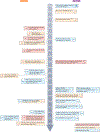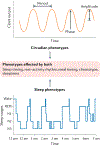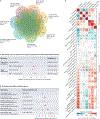Genetics of circadian rhythms and sleep in human health and disease
- PMID: 36028773
- PMCID: PMC10947799
- DOI: 10.1038/s41576-022-00519-z
Genetics of circadian rhythms and sleep in human health and disease
Abstract
Circadian rhythms and sleep are fundamental biological processes integral to human health. Their disruption is associated with detrimental physiological consequences, including cognitive, metabolic, cardiovascular and immunological dysfunctions. Yet many of the molecular underpinnings of sleep regulation in health and disease have remained elusive. Given the moderate heritability of circadian and sleep traits, genetics offers an opportunity that complements insights from model organism studies to advance our fundamental molecular understanding of human circadian and sleep physiology and linked chronic disease biology. Here, we review recent discoveries of the genetics of circadian and sleep physiology and disorders with a focus on those that reveal causal contributions to complex diseases.
© 2022. Springer Nature Limited.
Conflict of interest statement
Competing interests
The other authors report no competing interests.
Figures





References
Publication types
MeSH terms
Grants and funding
LinkOut - more resources
Full Text Sources

